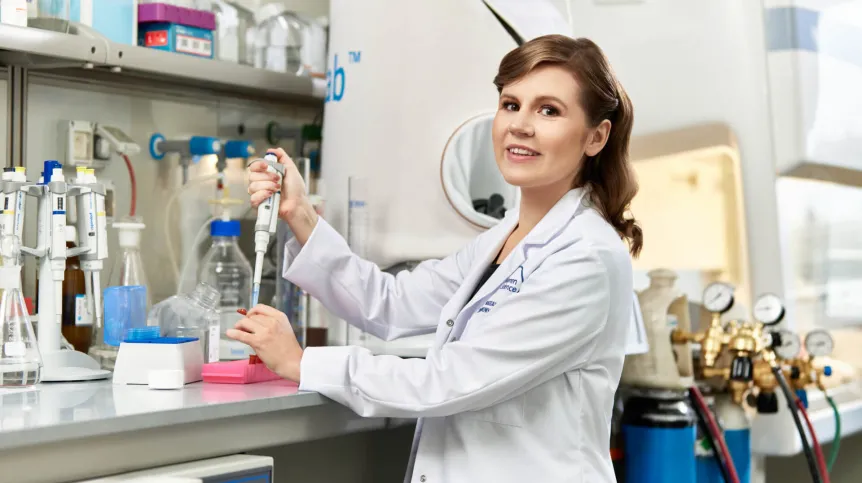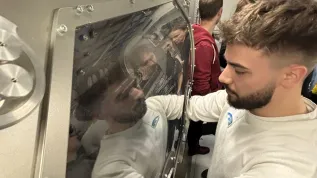
Polish scientists have destroyed the DNA of a cancer cell and blocked its repair mechanism by combining chemotherapy with radiotherapy to make the treatment safer, says Dr. Magdalena Zdrowowicz-Żamojć from the University of Gdańsk.
Radiotherapy is one of the three methods (along with chemotherapy and surgery) of fighting cancer. Its disadvantage, however, is that the ionising radiation used during the therapy destroys not only cancer cells, but also healthy tissue.
Just 50 years ago, radiotherapy for a uterine cancer an isolation unit involved placing a radioactive isotope in the genital tract and leaving the patient in an isolation unit for a month. In addition to its devastating effects on other organs, the isolation itself had an extremely negative impact on the patient's well-being.
However, the rapid development of new technologies has resulted in many innovative solutions in this area. The quality of equipment continues to improve, allowing doctors to more easily locate cancerous tumours and precisely direct radiation beams at them. Precision of treatment is also possible thanks to movable beds and better imaging quality.
Today, much safer and more precise accelerators are used instead of sources based on cobalt bombs, which dominated in Polish healthcare in the 1990s. Much lower doses of radiation are also used. For this purpose, fractionated radiotherapy is used, which means that the dose is divided into smaller fractions.
Despite improvements that have reduced the worst side effects, they have not yet been eliminated.
'To increase protection against radiological radiation, doses are lowered, but this leads to a problem with effectiveness. Another basic problem of radiotherapy at the cellular level is hypoxia, i.e. lack of oxygen in cancerous tumours. And this oxygen is very necessary because it perpetuates radiation damage to DNA It also turns out that ionising radiation destroys healthy cells up to three times faster than cancer cells - precisely because of this hypoxia,’ says Dr. Zdrowowicz-Żamojć.
Her research team focused on finding molecular and biochemical solutions to improve radiotherapy and unleash its potential.
'We believe that radiotherapy can be safer and more effective. We are looking for radiosensitisers that will sensitise cancer cells to ionising radiation. Such compounds would allow us to reduce the radiation dose to a value that would be much safer for the patient and more effective. Maybe it would even be possible to overcome the phenomenon of radioresistance in some cancerous tumours,’ she says.
The model for this work was research conducted with 5-bromo-2'-deoxyuridine (BrdU), whose radiosensitising properties had been studied for many years.
'We were looking for new compounds that could work on the same principle as bromodeoxyuridine. First, we examined the mechanism of this action and we know that it is a matter of electron addition - we know what bonds break when an electron is added. Therefore, we design analogues that will behave the same at the molecular level. These are completely new compounds - designed and tested by us from scratch,’ Zdrowowicz-Żamojć continues.
The researcher admits that the use of radiosensitisers in clinical practice is very difficult. One of the greatest difficulties is finding a way to enclose the drug in a carrier that will help deliver it to the selected place.
'There are many limiting issues. Clinical trials are difficult and take a long time. There are also other obstacles and questions along the way, e.g. how to make these compounds selectively reach the tumour (targeted therapy). These compounds are rapidly metabolised in the liver, so it may be necessary to use appropriate drug delivery strategies, using various features of cancer cells. We are planning research in this area,’ Zdrowowicz-Żamojć says.
She adds: 'I often compare the use of our radiosensitisers to a Trojan horse - that is, we introduce a compound that is theoretically neutral, not cytotoxic, which is insidiously incorporated into the DNA. However, when exposed to ionising radiation, it will cause a series of DNA damages, leading to the death of cancer cells. Compounds that we design and test are modified nucleosides - analogues of the natural building blocks of DNA. The goal of radiotherapy is the DNA molecule. A cell is composed of many components, but DNA is the command centre and the destruction of this biomolecule will result in the destruction and death of the cell. The goal is to induce the greatest number of DNA damages that will consequently lead to this.’
Chemical compounds are computer-designed. The team of scientists consists of theoretical chemists and experimenters.
'We have various models that help us determine that a given compound has certain features that make it a promising potential radiosensitiser. If a given compound passes computer tests, we proceed to synthesis and experimental research at the molecular and cellular level. All this research is carried out by our interdisciplinary research team,’ Zdrowowicz-Żamojć says.
Chemical compounds are tested on cell cultures. Scientists check their mechanism of action - they determine how these compounds cause cell death under the influence of radiation. Dr. Zdrowowicz-Żamojć’s original idea was to find a compound that, in addition to DNA damage, would also block the mechanism of repairing damaged DNA.
'Cancer cells are very clever. They have excellent and overactive repair mechanisms that eliminate radiation damage caused by ionising radiation. They do it much better than healthy cells,’ she explains.
Several solutions and applications proposed by the team in which the researcher works have already been awarded patent protection.
Zdrowowicz-Żamojć adds that they are also trying ‘to obtain funds to create and comprehensively equip a specialized laboratory that will enable animal testing of compounds.’
Dr. Magdalena Zdrowowicz-Żamojć is the winner of the L'Oréal-UNESCO For Women in Science 2023 competition.
PAP - Science in Poland, Urszula Kaczorowska
uka/ zan/ kap/
tr. RL













